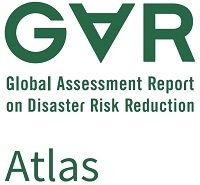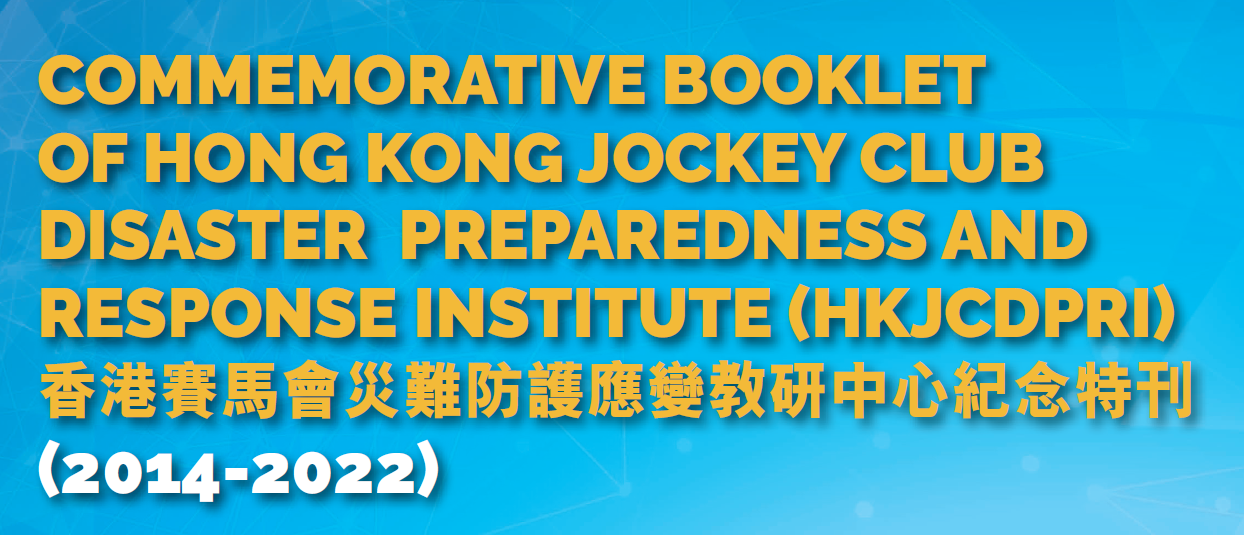You are here
Publications & Research
Publications & Research

Publications & Research
The HKJCDPRI Publications Section contains collaborative researches and publications with our partners and renowned academic institutions, and other research and development projects related to disaster preparedness and response.
The Guidelines section contains our selected collection of technical information, operational guidelines and useful tools for disaster management.
The Blog sub-section provides a platform where our team and peers share news and updates, as well as opinions and experiences in building disaster preparedness for the communities.
The blog posts are written by the author in his own personal capacity / affiliation stated. The views, thoughts and opinions expressed in the post belong solely to the author and does not necessarily represent those of Hong Kong Jockey Club Disaster Preparedness and Response Institute.
All resources listed here are freely and publicly available, unless specified otherwise. We ask users to use them with respect and credit the authors as appropriate.
2019

The United Nations system has a special leadership role in global risk and disaster reduction by its universal character, inter-disciplinary and multi-sectoral scope and role as a forum for global dialogue.
This session contains our selected documents and guidelines published by the United Nations system such as the United Nation Office for Disaster Risk Reduction (UNISDR), the United Nations Framework Convention On Climate Change (UNFCCC), The United Nations Human settlements Programme (UN-Habitat) and other related agencies.
*Descriptions of documents are taken from the source documents. The documents are not owned by the HKJCDPRI, and are freely and publicly available, unless specified otherwise. We ask users to use them with respect and credit the authors as appropriate.
Frameworks and Recommendations by UNISDR
Publication | Publication Year | Author | Description |
 | 2018 | UNISDR | This Strategic Approach to Capacity Development for Implementation of the Sendai Framework for Disaster Risk Reduction seeks to establish among all stakeholders a common understanding of capacity development within the disaster risk reduction (DRR) context. This Strategic Approach is a resource of empowerment for all relevant capacity development partners and stakeholders, and its goal - A Vision of Risk-Informed Sustainable Development by 2030. |
The Sendai Framework for Disaster Risk Reduction 2015-2030
| 2015 | UNISDR | The Sendai Framework for Disaster Risk Reduction 2015-2030 (Sendai Framework) is the first major agreement of the post-2015 development agenda, with seven targets and four priorities for action. The Sendai Framework is a 15-year, voluntary, non-binding agreement which recognises that the State has the primary role to reduce disaster risk but that responsibility should be shared with other stakeholders including local government, the private sector and other stakeholders. |
| 2005 | UNISDR | The Hyogo Framework for Action 2005-2015: Building the Resilience of Nations and Communities to Disasters (HFA) is the first plan to explain, describe and detail the work that is required from all different sectors and actors to reduce disaster losses. The HFA is a 10-year plan to make the world safer from natural hazards. |
International Strategy for Disaster Reduction
| 1999 | United Nations | The International Strategy for Disaster Reduction (ISDR) was launched by the Economic and Social Council and endorsed by the General Assembly as an international framework for responding to the challenge presented to the international community by the increasing incidence and scale of disasters. UNISDR was created as an inter-agency secretariat of ISDR together with the Inter-Agency Task Force on Disaster Reduction. |
Yokohama Strategy and Plan of Action for a Safer World
| 1994 | United Nations | The Yokohama Strategy for a Safer World: Guidelines for Natural Disaster Prevention, Preparedness and Mitigation and its Plan of Action was adopted at the 1994 First World Conference on Natural Disaster Reduction, building on the mid-term review of the International Decade for Natural Disaster Reduction. |
International Decade for Natural Disaster Reduction
| 1989 | United Nations | Given the increasing concern about the impact of disasters, the UN General Assembly declared 1990-1999 the International Decade for Natural Disaster Reduction (IDNDR). Initially, IDNDR was influenced largely by scientific and technical interest groups. However, the broader global awareness of the social and economic consequences of disasters caused by natural hazards developed as the decade progressed. |
Global Assessment Report (GAR) Disaster Risk Reduction
Publication | Publication Year | Author | Description |
| 2019 | UNISDR | This GAR is about understanding better the systemic nature of risk, how we are able to recognize, measure and model risk, and about strategies to enhance the scientific, social and political cooperation needed to move towards systemic risk governance. It reinforces the message that we need to reduce vulnerability and build resilience if we are to reduce risk. It looks at what countries and regional and international organizations have been doing according to formal reporting under the Sendai Framework Monitor (SFM). It also considers country practices in developing national and local plans to enhance risk reduction capacity, to integrate disaster risk reduction (DRR) with development planning and climate change adaptation (CCA), and to pay special attention to risk in rapidly growing cities and fragile/complex contexts. |
| 2017 | UNISDR | The GAR Atlas presents the output of a Global Risk Model (GRM) that can estimate the disaster risk associated with different kinds of hazard faced by national economies throughout the world. The model uses a state-of-the-art probabilistic approach analogous to that applied by the catastrophe modelling and insurance industry over recent decades. This model has been developed by a consortium of leading scientific and technical organisations, under the coordination of UNISDR. |
| 2015 | UNISDR | The fourth edition of the GAR is a resource for understanding and analysing global disaster risk today and in the future. The report explores the large potential losses from disasters currently face by many countries - especially those which can least afford to invest in future resilience and the cost and benefits of disaster risk management (DRM). |
| 2013 | UNISDR | The third edition of the United Nations Global Assessment Report on Disaster Risk Reduction (GAR) is a resource for understanding and analysing global disaster risk today and in the future. It explores why increasing disaster risks represent a growing problem for the economic and business community at different scales and examines how paradoxically business investments that aimed to strengthen competitiveness and productivity may have inadvertently contributed to increasing risk. |
| 2011 | UNISDR | The second edition of the United Nations Global Assessment Report on Disaster Risk Reduction is a resource for understanding and analysing global disaster risk today and in the future. Drawing on new and enhanced data, the 2011 report explores trends in disaster risk for each region and for countries with different socioeconomic development. At the same time, over 130 governments are engaged in self-assessments of their progress towards the Hyogo Framework for Action (HFA), contributing to what is now the most complete global overview of national efforts to reduce disaster risk. |
| 2009 | UNISDR | The 2009 Global Assessment Report on Disaster Risk Reduction (GAR) was launched in Bahrain on May 17, 2009. The Report provides hard-hitting evidence to demonstrate how, where and why disaster risk is increasing globally and presents key findings from a global analysis of disaster risk patterns and trends, including where high mortality and economic loss is concentrated. |
Framework and Recommendations on Climate Change
Publication | Publication Year | Author | Description |
Paris Agreement under the United Nations Framework Convention on Climate Change
| 2016 | United Nations Framework Convention On Climate Change (UNFCCC) | The Paris Agreement is an agreement within the United Nations Framework Convention on Climate Change (UNFCCC), dealing with greenhouse-gas-emissions mitigation, adaptation and finance, starting in the year 2020. |
Kyoto Protocol to the United Nations Framework Convention on Climate Change
| 1997 | United Nations | The Kyoto Protocol is an international agreement linked to the United Nations Framework Convention on Climate Change, which commits its Parties by setting internationally binding emission reduction targets. Recognising that developed countries are principally responsible for the current high levels of GHG emissions in the atmosphere as a result of more than 150 years of industrial activity, the Protocol places a heavier burden on developed nations under the principle of "common but differentiated responsibilities." |
United Nation Develpoment Goals
Publication | Publication Year | Author | Description |
Sustainable Development Goals (SDGs)
| 2015 | United Nations | Sustainable Development Goals are a collection of 17 global goals set by the United Nations General Assembly in 2015. The SDGs are part of Resolution 70/1 of the United Nations General Assembly: "Transforming our World: the 2030 Agenda for Sustainable Development." The goals are broad and interdependent, yet each has a separate list of targets to achieve. |
Millennium Development Goals (MDGs)
| 2000 | United Nations | The Millennium Development Goals (MDGs) were the eight international development goals for the year 2015. Each goal had specific targets and dates for achieving those targets. |
Framework and Recommendations from the United Nations Human Settlements Programme (Habitat)
Publication | Publication Year | Author | Description |
| 2016 | United Nations @Habitat | The New Urban Agenda was adopted at the United Nations Conference on Housing and Sustainable Urban Development (Habitat III) in Quito, Ecuador, on 20 October 2016. The New Urban Agenda represents a shared vision for a better and more sustainable future. If well-planned and well-managed, urbanisation can be a powerful tool for sustainable development for both developing and developed countries. The Habitat agenda is updated every two decades. Past versions can be seen here: Habitat II: The Istanbul Declaration on Human Settlements and the Habitat Agenda (published 1996) Habitat I: The Vancouver Declaration on Human Settlements (published 1976) |
Reference Materials for Humanitarian Response during Disasters
Publication | Publication Year | Author | Description |
Disaster Response in Asia and the Pacific: A Guide to International Tools and Services
| 2013 | UN Office for the Coordination of Humanitarian Affairs (OCHA) | Disaster Response in Asia and the Pacific: A Guide to International Tools and Services is designed to help disaster managers in national Governments gain basic knowledge of how to use international tools and services. It aims to support the growing disaster response and disaster response preparedness capabilities that exist at national level across Asia and the Pacific. |
Other Useful Tools
Publication | Publication Year | Author | Description |
| 2016 | UNISDR | The UNISDR Terminology aims to promote a common understanding and usage of disaster risk reduction concepts and to assist the disaster risk reduction efforts of authorities, practitioners and the public. |
| 2018 | UN OCHA | The 2018 set includes 295 icons covering topics such as humanitarian clusters, disasters, logistics, security incidents and a user experience/user interface design. |
1: Living with risk: a global review of disaster reduction initiatives. (2004). United Nations Office for Disaster Risk Reduction.

The Government of Hong Kong Special Administrative Region (HKSAR) has a comprehensive emergency services system, a variety of contingency plans and guidelines to safeguard the safety and wellbeing of the citizens in Hong Kong.
*The documents are not owned by the HKJCDPRI, and are freely and publicly available, unless specified otherwise. We ask users to use them with respect and credit the authors as appropriate.
Publication | Publication Year | Author | Description |
The Hong Kong Emergency Services
| 2018 | The Government of HKSAR | An overview and some quick facts on the Emergency Services in Hong Kong. |
Hong Kong Emergency Response Management
| Last revised 2018 | Security Bureau, The Government of the HKSAR | The Emergency Response System of Hong Kong and the specific Contingency Plans stipulating the roles and responsibilities of different government departments on various disasters. |
Guidelines for health professionals of Hong Kong on health protection
| Updated regularly | Centre for Health Protection, Department of Health, The Government of the HKSAR | Recommendations for health workers on the treatments and protocols of dealing with various infectious diseases, non-communicable diseases and laboratory testings. |
2016

On 8 April 2015, the World Health Organization (WHO) announced the newly set up Global Foreign Medical Teams Registry which would enable WHO to build a global roster of foreign medical response teams (FMT) ready to be deployed in sudden onset disasters such as earthquakes, tsunamis, cyclones, floods, and disease outbreaks.


























